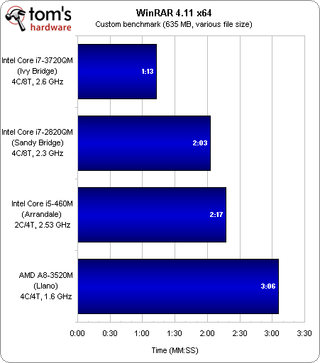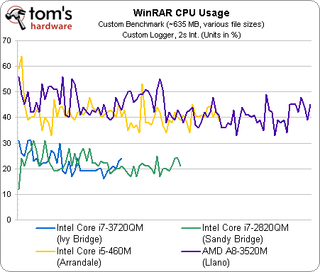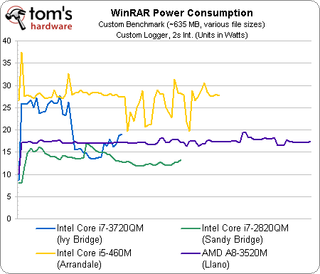Core i7-3720QM: Ivy Bridge Makes Its Mark On Mobility
Benchmark Results: WinRAR 4.11

WinRAR is one of three archival apps normally found in our processor reviews. Historically, it's far better-threaded than WinZip (though a recent update to WinZip 16.5 might change this), but it doesn't always scale as well as 7-Zip. It's a good middle-ground, and it remains a very popular title amongst our readers.
We rarely see WinRAR achieve high processor utilization numbers, likely as a result of a storage bottleneck. But the outcome is similar to Photoshop anyway. The Ivy Bridge-based platform soars into a lead, followed by the Core i7-2820QM, which itself is trailed by the Core i5-460M. Again, AMD's A8 simply cannot keep up.

Both Bridges enjoy relatively low processor utilization numbers. The Core i7-3720QM gets its job done faster with a spike in power consumption, though, while Core i7-2820QM takes a lot longer, but maintains remarkably low power use. The result is roughly a wash in terms of energy efficiency.
Core i5-460M takes longer and uses more power (not a good combination). Although it's the slowest solution of all, at least AMD's A8 maintains steady consumption under 20 W.

Stay on the Cutting Edge
Join the experts who read Tom's Hardware for the inside track on enthusiast PC tech news — and have for over 25 years. We'll send breaking news and in-depth reviews of CPUs, GPUs, AI, maker hardware and more straight to your inbox.
Current page: Benchmark Results: WinRAR 4.11
Prev Page Benchmark Results: Adobe Photoshop CS 5 Next Page Benchmark Results: iTunes 10.6.1-
fstrthnu Would there be a noticeable performance gap between the i7-3720QM and the i7-3612/5QM? I'm trying to decide whether the extra 300 Mhz is worth ~$150 more (which I'm guessing not really)Reply -
s3anister fstrthnuWould there be a noticeable performance gap between the i7-3720QM and the i7-3612/5QM? I'm trying to decide whether the extra 300 Mhz is worth ~$150 more (which I'm guessing not really)Reply
There would be a performance difference in applications that could use the extra MHz (Video games, encoding/decoding) and performance would scale accordingly. Otherwise no you'd likely never notice. -
dragonsqrrl Wow, it looks like Ivy Bridge is a very compelling option in the mobile market. I had no idea the mobile versions of Llano were so performance constrained by their TDP. The graphics performance results are especially interesting. Just turned my whole world view upside down.Reply
Great job. Another excellent review Andrew. -
fstrthnu It looks like the Geforce GT650M in the notebook I'm looking at would bottleneck faster than the processor would, so I guess I'll save $$ thenReply -
DjEaZy ... why there waz no screenshots of picture quality differences in games between intel's HD4000 and AMD's HD6620?Reply -
blazorthon dragonsqrrlWow, it looks like Ivy Bridge is a very compelling option in the mobile market. I had no idea the mobile versions of Llano were so performance constrained by their TDP. The graphics performance results are especially interesting. Just turned my whole world view upside down.Great job. Another excellent review Andrew.Reply
To be fair, it was a low power APU being bench-marked against higher end, higher power, and newer chips. I would be surprised if it won much of anything, besides power usage, against the Sandy and Ivy i7s. A higher TDP mobile A8 might be able to beat HD 4000 if it had 1600MHz or maybe even 1866MHz memory, granted it still wouldn't win in CPU performance. -
ojas Interesting review. But i guess people are likely to point out differences in price (thus affecting performance/$), and RAM speeds, which apparently impact IGP performance.Reply
IIRC, the IGPs on the mobile chips can be OC'd, right?
The Core i7-3720QM particularly shines in tests involving:
Hmmm...wouldn't you agree that "data decryption" should be on this list too? The difference b/w each proc is significant...plus you've got hardware acceleration for AES256 on SB and IB...
Video Transcoding
DX9 Graphics
Web Browsing
I hope the mobile i3s get HD4000...still wondering why the i5s didn't get it... -
DavidC1 Andrew, love the review. But there's what seems to be a big error. You said on the power usage tests that AMD defaults to max battery life while Intel goes to balanced? Looking at World of Warcraft results, it looks like all the other results may be running max battery life mode for the AMD A8 chip.Reply
The i5-460M is faster than A8-3520M, just not that much faster. I have a feeling you need to run the application and gaming tests on max performance all over again. It doesn't matter for the Intel part as Balanced pretty much performs like max performance. -
DavidC1 Also, you need to do a battery life test. Power usage and battery life tests are hard to connect, because of advanced power management techniques and different usage models.Reply
Most Popular

